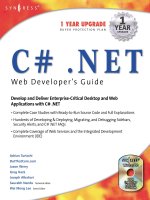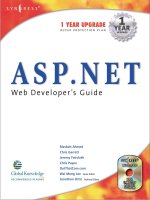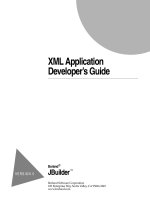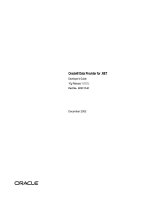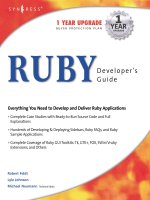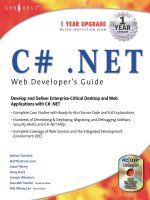C# web developer s guide
Bạn đang xem bản rút gọn của tài liệu. Xem và tải ngay bản đầy đủ của tài liệu tại đây (6.81 MB, 817 trang )
1 YEAR UPGRADE
BUYER PROTECTION PLAN
Develop and Deliver Enterprise-Critical Desktop and Web
Applications with C# .NET
• Complete Case Studies with Ready-to-Run Source Code and Full Explanations
• Hundreds of Developing & Deploying, Migrating, and Debugging Sidebars,
Security Alerts, and C# .NET FAQs
• Complete Coverage of Web Services and the Integrated Development
Environment (IDE)
Adrian Turtschi
DotThatCom.com
Jason Werry
Greg Hack
Joseph Albahari
Saurabh Nandu
Technical Editor
Wei Meng Lee
Series Editor
C# .NET
Web Developer’s Guide
With more than 1,500,000 copies of our MCSE, MCSD, CompTIA, and Cisco
study guides in print, we continue to look for ways we can better serve the
information needs of our readers. One way we do that is by listening.
Readers like yourself have been telling us they want an Internet-based ser-
vice that would extend and enhance the value of our books. Based on
reader feedback and our own strategic plan, we have created a Web site
that we hope will exceed your expectations.
is an interactive treasure trove of useful infor-
mation focusing on our book topics and related technologies. The site
offers the following features:
■
One-year warranty against content obsolescence due to vendor
product upgrades. You can access online updates for any affected
chapters.
■
“Ask the Author” customer query forms that enable you to post
questions to our authors and editors.
■
Exclusive monthly mailings in which our experts provide answers to
reader queries and clear explanations of complex material.
■
Regularly updated links to sites specially selected by our editors for
readers desiring additional reliable information on key topics.
Best of all, the book you’re now holding is your key to this amazing site.
Just go to www.syngress.com/solutions, and keep this book handy when
you register to verify your purchase.
Thank you for giving us the opportunity to serve your needs. And be sure
to let us know if there’s anything else we can do to help you get the
maximum value from your investment. We’re listening.
www.syngress.com/solutions
167_C#_FM.qxd 12/5/01 10:16 AM Page i
167_C#_FM.qxd 12/5/01 10:16 AM Page ii
1 YEAR UPGRADE
BUYER PROTECTION PLAN
Adrian Turtschi
DotThatCom.com
Jason Werry
Greg Hack
Joseph Albahari
Saurabh Nandu
Technical Editor
Wei Meng Lee
Series Editor
C# .NET
Web Developer’s Guide
167_C#_FM.qxd 12/5/01 10:16 AM Page iii
Syngress Publishing, Inc., the author(s), and any person or firm involved in the writing, editing, or
production (collectively “Makers”) of this book (“the Work”) do not guarantee or warrant the results to be
obtained from the Work.
There is no guarantee of any kind, expressed or implied, regarding the Work or its contents.The Work is
sold AS IS and WITHOUT WARRANTY. You may have other legal rights, which vary from state to state.
In no event will Makers be liable to you for damages, including any loss of profits, lost savings, or other
incidental or consequential damages arising out from the Work or its contents. Because some states do not
allow the exclusion or limitation of liability for consequential or incidental damages, the above limitation
may not apply to you.
You should always use reasonable care, including backup and other appropriate precautions, when working
with computers, networks, data, and files.
Syngress Media®, Syngress®,“Career Advancement Through Skill Enhancement®,” and “Ask the Author
UPDATE®,” are registered trademarks of Syngress Publishing, Inc. “Mission Critical™,”“Hack Proofing™,”
and “The Only Way to Stop a Hacker is to Think Like One™” are trademarks of Syngress Publishing, Inc.
Brands and product names mentioned in this book are trademarks or service marks of their respective
companies.
KEY SERIAL NUMBER
001 CDFE48952P
002 NHBN9436KH
003 BAEN24P7BV
004 HY9W84UJTA
005 RTW9B39RE4
006 JSE4FAHT82
007 VTS8TYCGF2
008 AUTGFLDCWR
009 833K74SLAF
010 VFR4MHY3XW
PUBLISHED BY
Syngress Publishing, Inc.
800 Hingham Street
Rockland, MA 02370
C# .NET Web Developer’s Guide
Copyright © 2002 by Syngress Publishing, Inc. All rights reserved. Printed in the United States of America.
Except as permitted under the Copyright Act of 1976, no part of this publication may be reproduced or
distributed in any form or by any means, or stored in a database or retrieval system, without the prior
written permission of the publisher, with the exception that the program listings may be entered, stored,
and executed in a computer system, but they may not be reproduced for publication.
Printed in the United States of America
1 2 3 4 5 6 7 8 9 0
ISBN: 1-928994-50-4
Technical Editor: Saurabh Nandu Freelance Editorial Manager: Maribeth Corona-Evans
Co-Publisher: Richard Kristof Cover Designer: Michael Kavish
Acquisitions Editor: Catherine B. Nolan Page Layout and Art by: Shannon Tozier
Developmental Editor: Kate Glennon Copy Editor: Darren Meiss
CD Production: Michael Donovan Indexer: Rich Carlson
Distributed by Publishers Group West in the United States and Jaguar Book Group in Canada.
167_C#_FM.qxd 12/5/01 10:16 AM Page iv
vv
We would like to acknowledge the following people for their kindness and support in
making this book possible:
Richard Kristof and Duncan Anderson of Global Knowledge, for their generous access
to the IT industry’s best courses, instructors, and training facilities.
Ralph Troupe, Rhonda St. John, and the team at Callisma for their invaluable insight into
the challenges of designing, deploying and supporting world-class enterprise networks.
Karen Cross, Lance Tilford, Meaghan Cunningham, Kim Wylie, Harry Kirchner, Kevin
Votel, Kent Anderson, and Frida Yara of Publishers Group West for sharing their
incredible marketing experience and expertise.
Mary Ging, Caroline Hird, Simon Beale, Caroline Wheeler,Victoria Fuller, Jonathan
Bunkell, and Klaus Beran of Harcourt International for making certain that our vision
remains worldwide in scope.
Annabel Dent of Harcourt Australia for all her help.
David Buckland,Wendi Wong, Marie Chieng, Lucy Chong, Leslie Lim, Audrey Gan, and
Joseph Chan of Transquest Publishers for the enthusiasm with which they receive our
books.
Kwon Sung June at Acorn Publishing for his support.
Ethan Atkin at Cranbury International for his help in expanding the Syngress program.
Jackie Gross, Gayle Vocey, Alexia Penny, Anik Robitaille, Craig Siddall, Darlene Morrow,
Iolanda Miller, Jane Mackay, and Marie Skelly at Jackie Gross & Associates for all their
help and enthusiasm representing our product in Canada.
Lois Fraser, Connie McMenemy, and the rest of the great folks at Jaguar Book Group for
their help with distribution of Syngress books in Canada.
Acknowledgments
167_C#_FM.qxd 12/5/01 10:16 AM Page v
Contributors
Todd Carrico (MCDBA, MCSE) is a Senior Database Engineer for
Match.com. Match.com is a singles portal for the digital age. In addition to its
primary Web site, Match.com provides back-end services to AOL, MSN, and
many other Web sites in its affiliate program.Todd specializes in design and
development of high-performance, high-availability data architectures primarily
on the Microsoft technology. His background includes designing, developing,
consulting, and project management for companies such as Fujitsu, Accenture,
International Paper, and GroceryWorks.com. In addition to his contribution to
C# .NET Web Developer’s Guide,Todd has also contributed chapters to other
books in the Syngress .NET Series including the ASP .NET Web Developer’s
Guide, and the VB .NET Developer’s Guide.Todd resides in Sachse,TX, with his
wife and two children.
Mark Tutt is a Senior Software Engineer with MICROS Systems. MICROS
provides complete information management solutions for the hospitality
industry, including software, hardware, enterprise systems integration, consulting,
and support. Mark is the principle designer of a number of software packages,
including Guest Service Solution, a customer relationship management system
for the MICROS Restaurant Enterprise Series platform. In addition to his
product development duties, Mark is a key contributor to the design and devel-
opment of system integration software and customer-specific product exten-
sions that allow MICROS clients to fully integrate MICROS products into
their overall technology plans. Mark currently resides in Baltimore, Maryland
with his wife Malinda and their twin sons, Fred and Jackson.
Jason Werry (MCSD) runs a consulting firm, Synergy Data Solutions, in
Australia. He currently provides strategic and technical consulting to his clients
and specializes in Windows-based enterprise systems development. Jason has an
extensive background using Microsoft technologies and is currently developing
state-of-the-art,Web-based applications on the .NET platform. His clients have
ranged from a Taiwanese multimedia company to various government depart-
ments and local startups. A natural born programmer, Jason started coding
Z80 processors in Assembly at age 13. Since then he has used most popular
vi
167_C#_FM.qxd 12/5/01 10:16 AM Page vi
vii
programming languages and presently enjoys working with SQL Server, MTS,
IIS,Visual Basic, and C#. Jason holds a bachelor’s degree in Mathematics/
Computer Science from The University of Queensland. He dedicates his
writing to his loving wife, LiHsing.
Patrick Coelho (MCP) is an Instructor at The University of Washington
Extension, North Seattle Community College, Puget Sound Center, and Seattle
Vocational Institute, where he teaches courses in Web Development (DHTML,
ASP, XML, XSLT, C#, and ASP .NET). Patrick is a Co-Founder of
DotThatCom.com, a company that provides consulting, online development
resources, and internships for students. He is currently working on a .NET
solution with contributing author David Jorgensen and nLogix. Patrick holds a
Bachelor’s of Science degree from the University of Washington, Bothell.
Patrick lives in Puyallup,WA with his wife Angela.
David Jorgensen (MCP) is an Instructor at North Seattle Community
College, University of Washington extension campus, and Puget Sound Centers.
He is also developing courses for Seattle Vocational Institute, which teaches
.NET and Web development to the underprivileged in the Seattle area. David
also provides internship opportunities through his company DotThatCom.com,
which does online sample classes and chapters of books. David holds a bach-
elor’s degree in Computer Science from St. Martin’s College and resides in
Puyallup,WA with his wife Lisa and their two sons Scott and Jacob.
Greg Hack is a Senior Software Engineer with Allscripts Healthcare Solutions.
Greg has over 15 years experience developing software on platforms ranging
from the mainframe to the desktop using a wide variety of languages and tech-
nologies. Recent work includes a Web-based application that allows patients to
view their medical records and a Pocket PC application that delivers clinical
information to physicians at the point of care.
Axel Goldbach is a Senior Consultant with modulo3 GmbH, a consulting
company based in Germany and specializing in project management consulting
throughout Europe. modulo3 is a process implementation specialist for the
major networking frameworks, including eXtreme Programming, MSF and
V Modell. Axel currently provides senior-level strategic and technical consulting
to all modulo3 clients in Germany and Central Europe. His duties include anal-
ysis and development of multi-tiered applications in heterogeneous environments.
167_C#_FM.qxd 12/5/01 10:16 AM Page vii
viii
Axel also works as a technical scout and trainer for modulo3. His training spe-
cialties include programming languages, networking, and academic fields such as
development methodology, parser- and interpreter-technology, theory of com-
plexity, and provable correct software.
Joseph Albahari is a freelance consultant and developer with over 10 years
experience in designing networked systems. He has led a string of successful
projects, from custom application frameworks for start-up companies, to high-
performance OLAP and data warehousing systems for telecommunications
giants. His knowledge in object-oriented user interface design has been called
upon in the planning or production of many large and complex systems, where
well-balanced abstractions are of key importance. Joseph is also experienced in
SQL Server database administration, and has developed high-performance solu-
tions for clients with specialized requirements—such as a replication system
providing field level synchronization, or a high-throughput bulk-copying agent.
Joseph holds a Bachelor’s degree in computer science and physics.
Adrian Turtschi (MCSE, MCSD) is Lead Architect Solution Development
with Avanade (Germany), where he is responsible for the solution offering in
the mobile computing space. He has been working on the Microsoft .NET
platform since fall 2000, specializing in developing enterprise systems using Web
Services. He is particularly interested in using Web Services to bridge platform
and system boundaries. Prior to joining Avanade, Adrian worked for KPMG’s
Global Knowledge Exchange in Boston, where he helped design and develop
KPMG's global knowledge management and collaboration solution, used by its
100,000 professionals world-wide. Adrian has work experience in Switzerland,
the Netherlands, and the US. He has degrees in Mathematics and Computer
Science. He currently lives in Berlin, Germany.
167_C#_FM.qxd 12/5/01 10:16 AM Page viii
ix
Technical Editor and Reviewer
Saurabh Nandu is the Founder of www.MasterCSharp.com which concen-
trates on teaching C# and .NET. He worked with HTML, JavaScript, Flash 5.0
before he started programming in Java. Saurabh has been impressed by the
power and flexibility of .NET. He is currently employed by YesSoftware Inc.
as Technical Evangelist.
Technical Editor’s Acknowledgements
I would like to thank my friend Nanu Jogi without whose direction I would
have never got into working on the .NET Platform. I would also like to thank
my family, especially my brother Pritesh, for their support.
Wei Meng Lee is Series Editor for Syngress Publishing’s .NET Developer
Series. He is currently lecturing at The Center for Computer Studies, Ngee
Ann Polytechnic, Singapore.Wei Meng is actively involved in Web development
work and conducts training for Web developers and Visual Basic programmers.
He has co-authored two books on WAP. He holds a Bachelor’s degree in
Information Systems and Computer Science from the National University of
Singapore.The first and second books of the .NET series, VB .NET Developer’s
Guide (ISBN: 1-928994-48-2), and ASP .NET Developer’s Guide (ISBN:
1-928994-51-2) are currently available from Syngress Publishing.
Series Editor
167_C#_FM.qxd 12/5/01 10:16 AM Page ix
x
This CD-ROM contains the code files that are used in each chapter of this book.The
code files for each chapter are located in a chXX directory (for example, the files for
Chapter 8 are in the ch08 directory). Any further directory structure depends on the pro-
jects that are presented within the chapter.
To work with the examples provided, you will need at least the Windows 2000 or
Windows XP Professional operating system with the latest service packs, IIS 5.x, and IE
6.0, since ASP.NET and Web Services (a part of ASP.NET) are not supported on earlier
operating systems such as Windows 9x/WindowsME/WindowsNT. Also needed is the
.NET SDK Beta2 (the latest public release available while writing this book) and the
Visual Studio.NET Beta2 IDE.
The C# .NET Web Developer’s Guide provides you with extensive examples that will
help solve the problems you might face while developing applications for the .NET
Platform rather than concentrating on the theory of C# and .NET programming.
Therefore code is the main feature of this book.
The chapters contain both code snippets and sample programs that illustrate the
principles discussed. Chapter 2 presents a series of sample programs that introduce con-
cepts in C# that are different from other object-oriented languages. Chapter 4 helps you
understand the basics of building Graphical User Interface (GUI)-rich Windows Forms
applications; the examples presented in this chapter are the launch pad for Windows
Forms applications used in other chapters. Similarly, code presented in Chapter 8 helps
you to interact with various databases using ADO.NET; again, this chapter acts as a foun-
dation for further chapters’ database coverage. Chapter 9 will acquaint you with using
.NET Class Libraries to interact with XML and its related technologies.
Chapters 5, 6, and 11 discuss technologies and Application Program Interfaces (APIs)
that help two applications to communicate and interact with each other. Chapter 5
focuses on enabling applications to communicate over the TCP and UDP protocols and
provides an overview of the techniques used to interact with Web pages programmatically.
Code examples in Chapter 6 and Chapter 11 concentrate on using Simple Object Access
Protocol (SOAP) and object serialization and deserialization.
About the CD
167_C#_FM.qxd 12/5/01 10:16 AM Page x
xi
Chapter 7 examples examine message delivery in distributed applications using
Microsoft Message Queuing (MSMQ). Chapter 10 takes a comprehensive look at
ASP.NET and helps you build various applications of increasing complexity and func-
tionality, starting with an XML Poll, progressing to a SQL-powered Message Board, and
ending with a Shopping Cart.
Lastly, to end on a lighter note, Chapter 12 takes you through building a Jokes Web
Service.The code in this chapter helps you build both the Jokes Web Service as well as
the Windows Forms Client for the service.
Look for this CD icon to obtain files used
in the book demonstrations.
167_C#_FM.qxd 12/5/01 10:16 AM Page xi
xii
From the Series Editor
For many years, C and C++ programmers have been searching for alternative pro-
gramming languages that offer the same kind of flexibility and power of C and C++,
but without the complexities and steep learning curve required for mastery of the
language.What many programmers desired was a language that would allow applica-
tions to be built rapidly, but at the same time giving them the ability to code at low
level.The search has finally ended with Microsoft’s new language—C#, a member of
the .NET Framework.
C# is the revolutionary new language from Microsoft, designed solely to run on
the .NET framework. Drawing experiences from C, C++, and Visual Basic, C# was
designed to be a simple and modern object oriented programming language.
But why learn C#? With the integration of C# and the Visual Studio.NET
(known as Visual C#), developing Windows and Web applications has been radically
simplified.With full access to the .NET Class Libraries, C# includes built-in support
for developing robust Web services and ASP.NET applications. (It was reportedly said
that Visual Studio.NET was built entirely using C# and that most of the examples in
MSDN were coded in C#.That in and of itself is a very good reason to learn C#!)
Besides this, C# enhances the productivity of programmers by eliminating common
errors often associated with C and C++.
While many of the earlier C# books have primarily focused on the language
syntax, The C# .NET Web Developer’s Guide illustrates the uses of C# for Web devel-
opers looking to harness the new functionality and ease of this powerful program-
ming language.The best way to learn a new language is by trying out the examples
while you are reading this book.Within many chapters, you will find numerous code
examples used in various practical situations; this hands-on, code-intensive approach
allows you to have a deeper understanding of issues involved in C# Web develop-
ment, and at the same time allows you to cut and paste portions of applicable code
into your current projects, thereby shortening development time.
We are constantly working hard to produce the best technical books needed by
professional programmers like you. I sincerely hope you will enjoy reading this book
as much as the authors did writing it!
Wei Meng Lee, Series Editor
Syngress .NET Developer Series
167_C#_FM.qxd 12/5/01 10:16 AM Page xii
Seldom in the history of computer software has any technology received such a posi-
tive response from developers and the industry, even while the technology is still in
its nascent beta stage.The .NET Beta2 SDK from Microsoft has already been down-
loaded by millions of developers all over the world.There have been dozens of pub-
lished books,Web sites and newsgroups devoted to the .NET platform, its related
technologies and languages.
Microsoft has invested billions of dollars and years of research in the creation of
.NET. .NET is a comprehensive strategy ,consisting of operating systems, database
servers, application servers, and the .NET Runtime, as well as managed languages
that operate over the .NET platform.
Many people see the .NET platform as the practical implementation of the pre-
viously formulated Windows DNA. Others see it as a response to developer woes
from working with previous technologies and languages. However, the common
opinion simply offers that .NET is a significant improvement over previous Microsoft
technologies.The .NET platform has been built from the ground up with numerous
goals in mind, including security, scalability, reliability, flexibility, and interoper-
ability—these goals have all been dealt with from the start to help to make the .NET
platform enterprise ready and developer-friendly.
The .NET platform displays a significant shift in Microsoft’s thinking.While
building the .NET platform, Microsoft has shown strong support for open standards
like XML, SOAP, and UDDI, rather than building its own proprietary standards and
technologies. Even the core part of the .NET platform—the Common Language
Infrastructure (CLI)—and the C# specifications have been placed before ECMA for
standardization.
C# is defined as a simple, modern, object-oriented, and type-safe programming
language derived from C and C++. Developed by Anders Hejlsberg of Microsoft
especially for the .NET platform, C# derives its features from a number of languages
xxi
Foreword
167_C#_fore.qxd 12/4/01 2:49 PM Page xxi
xxii Preface
like C, C++, and Java. Specifically written to offer the simplicity of Visual Basic and
power of C++ as an object-oriented language, C# makes it easier for developers to
create, debug, and deploy enterprise applications. It has also been predicted that C#
will become the favored language for developing applications on the .NET platform.
Visual Studio.NET, the next version of Visual Studio IDE, is also a key compo-
nent of the .NET strategy.The Visual Studio.NET IDE has also been given a facelift
and packed with a wide variety of new functionalities. A bitmap editor, debugger,
Web Forms designer,Windows Forms designer,Web Services designer, XML editor,
HTML editor,Web browser, Server Resources Explorer, and multi-language support
have all been packed into one single IDE.
The focus of The C#.NET Web Developer’s Guide is not on teaching you the core
C# language, but rather providing you with code examples that will help you
leverage the functionalities of the .NET Framework Class Libraries.The .NET
Framework collection of base classes cover many of the multiple APIs. Although
impossible for one book to cover all the features, in this book we have covered the
key concepts, libraries, and APIs of the .NET Framework that we feel will help you
easily create new applications using C#.
You have a whole host of features to learn and master, so why wait? Let’s get
started!!
—Saurabh Nandu,Technical Editor
Founder, www.MasterCSharp.com
www.syngress.com
167_C#_fore.qxd 12/4/01 2:49 PM Page xxii
xiii
Contents
Foreword xxi
Chapter 1 Introducing the Microsoft .NET Platform 1
Introduction 2
Introducing the.NET Platform 2
Microsoft .NET and Windows DNA 3
Microsoft .NET Architecture Hierarchy 4
Features of the .NET Platform 5
Multilanguage Development 5
Platform and Processor Independence 7
Automatic Memory Management 7
Versioning Support 8
Support for Open Standards 9
Easy Deployment 9
Distributed Architecture 10
Interoperability with Unmanaged Code 11
Security 12
Performance and Scalability 14
Components of the .NET Architecture 14
.NET Runtime 14
Managed/Unmanaged Code 14
Intermediate Language 15
Common Type System 15
.NET Base Class Library (BCL) 15
Assemblies 16
Metadata 16
Assemblies and Modules 17
Assembly Cache 18
Reflection 19
Just In Time Compilation 19
Garbage Collection 20
Exploring the Code Cycle 21
The Pursuit of Standardization 24
Summary/Solutions Fast Track/Frequently Asked Questions 26
Chapter 2 Introducing C# Programming 33
Introduction 34
Getting Started 35
Creating Your First C# Program 37
Compiling and Executing 38
Defining a Class 40
Declaring the Main Method 43
Organizing Libraries with Namespaces 43
167_C#_TOC.qxd 12/5/01 11:44 AM Page xiii
xiv Contents
Using the using Keyword 44
Adding Comments 45
Introducing Data Types 47
Value Types 47
Primitive Data Types 47
Reference Types 48
Explaining Control Structures 49
Using the if Statement 49
Using the if-else Statement 50
Using the switch case Statement 50
Using the for Statement 51
Using the while Statement 52
Using the do while Statement 52
Using the break Statement 52
Using the continue Statement 53
Using the return Statement 54
Using the goto Statement 55
Understanding Properties and Indexers 56
Using Properties 56
Get Accessor 59
Set Accessor 59
Accessing Lists with Indexers 60
Using Delegates and Events 69
Delegates 70
Single Cast 74
Multicast 75
Events 79
Using Exception Handling 85
Using the try Block 89
Using the catch Block 89
Using the finally Block 89
Using the throw Statement 89
Understanding Inheritance 90
Summary/Solutions Fast Track/Frequently Asked Questions 104
Chapter 3 Visual Studio.NET IDE 109
Introduction 110
Introducing Visual Studio.NET 110
Components of VS.NET 112
Design Window 112
Code Window 113
Server Explorer 114
Toolbox 116
Docking Windows 117
Properties Explorer 117
Solution Explorer 118
Object Browser 119
Dynamic Help 120
Task List Explorer 121
167_C#_TOC.qxd 12/5/01 11:44 AM Page xiv
Contents xv
Features of VS.NET 122
IntelliSense 122
XML Editor 124
Documentation Generation (XML Embedded Commenting) 127
Adding XML Document Comments to C# Pages 127
Customizing the IDE 129
Creating a Project 130
Projects 130
Creating a Project 130
Add Reference 131
Build the Project 131
Debugging a Project 132
Summary/Solutions Fast Track/Frequently Asked Questions 133
Chapter 4 Windows Forms 137
Introduction 138
Introducing Windows Forms 138
Writing a Simple Windows Forms Application 141
Adding Controls 142
Adding an Event Handler 145
Adding Controls at Runtime 147
Attaching an Event Handler at Runtime 152
Writing a Simple Text Editor 154
Starting the Project 154
Creating a Menu 155
Adding a New Form 157
Creating a Multiple Document Interface 159
Creating a Dialog Form 160
Using Form Inheritance 162
Adding a TabControl 164
Anchoring Controls 166
Changing the Startup Form 167
Connecting the Dialog 167
Using the ListView and TreeView Controls 170
Building an ImageList 170
Adding a ListView 172
Using the Details View 173
Attaching a Context Menu 174
Adding a TreeView 175
Adding a Splitter 177
Implementing Drag and Drop 178
Creating Controls 181
Creating a User Control 181
Adding a Property 182
Adding Functionality 182
Writing a Custom Control 183
Testing the Control 187
Enhancing the Control 189
Subclassing Controls 191
167_C#_TOC.qxd 12/5/01 11:44 AM Page xv
xvi Contents
Custom Controls in Internet Explorer 193
Setting Up IIS 193
Creating a Virtual Directory 193
Writing a Test Page 194
Summary/Solutions Fast Track/Frequently Asked Questions 196
Chapter 5 Network Programming:
Using TCP and UDP Protocols 203
Introduction 204
Introducing Networking and Sockets 204
Introduction to TCP 206
Introduction to UDP 208
Introduction to Ports 211
System.Net Namespace 212
System.Net.Sockets Namespace 213
Example TCP Command Transmission and Processing 214
General Usage of Needed .NET Classes 216
The Server 217
The Client 220
Compiling and Running the Example 226
Example UDP Command Transmission and Processing 227
General Usage of Needed .NET Classes 228
The Server 229
The Client 231
Compiling and Running the Example 234
Creating a News Ticker Using UDP Multicasting 235
General Usage of Needed .NET Classes 236
The Server 240
The Client 243
Compiling and Running the Example 250
Creating a UDP Client Server Chat Application 250
The TCPServerSession Class 253
The TCPServer Class 256
The Chat Protocol 260
The ChatServer Class 260
The ChatClient Class 265
Compiling and Running the Example 268
Creating a TCP P2P File Sharing Application 269
The Remote File Stream Protocol 271
The RemoteFileStreamServer Class 272
The RemoteFileStreamProxy Class 276
The FileSharingPeer Class 279
Compiling and Running the Example 283
Access to Web Resources 283
General Usage of Needed .NET Classes 284
A Web Access Client 285
Compiling and Running the Example 289
Request Method 290
Redirection 290
167_C#_TOC.qxd 12/5/01 11:44 AM Page xvi
Contents xvii
Authentication 291
Cookies 291
Summary/Solutions Fast Track/Frequently Asked Questions 292
Chapter 6 Remoting 299
Introduction 300
Introducing Remoting 301
Remoting Architecture 302
Creating a Simple Remoting Client Server 303
Creating the Remote Server Object 303
Creating the Hosting Application 305
Creating the Client Application 306
Understanding the Remoting Code 308
Improving the Sample Application 310
Adding Event Logging and Error Handling 310
Using the soapsuds Tool 312
Using Configuration Files 313
Updating Configuration Files Using the .NET
Framework Configuration Tool 318
Changing the Hosting Application to a Service 319
Using the TCP Channel with the Binary Formatter 321
Summary of the Improved Sample Application 321
Creating an Intranet Application 321
Object Lifetime and Leasing 321
Creating the CountServer Project 322
Creating the CountHost Project 325
Creating the CountClient Project 326
Understanding the Leasing and Sponsorship Code 329
Client Activated Objects 331
Sending and Receiving Objects by Value 332
Sending and Receiving Objects by Reference 333
Creating Service-Based Applications 334
Building a Versioned Remoting Application 334
Creating the VersionHost Project 336
Creating the VersionClient Project 337
Testing Side-By-Side Execution of Remote Objects 339
Summary/Solution Fast Track/Frequently Asked Questions 340
Chapter 7 Message Queuing Using MSMQ 345
Introduction 346
Introducing MSMQ 346
MSMQ Architecture 348
Installing MSMQ 349
Using Visual Studio to Manage Queues 349
Creating a Simple Application 349
Understanding the Messaging Code 353
Sending Messages 353
Message Formats 355
Sending and Receiving Messages with Complex Objects 356
Storing Files within Messages 360
167_C#_TOC.qxd 12/5/01 11:44 AM Page xvii
xviii Contents
Setting Queue Options 364
Creating a Complex Application 365
Creating the MSMQGraphics Drawing Library 366
Creating the DrawingSender Project 369
Creating the DrawingReceiver Project 373
Creating an Asynchronous Application 376
Using Public Queues While Disconnected from the Network 378
Summary/Solutions Fast Track/Frequently Asked Questions 379
Chapter 8 ADO.NET 383
Introduction 384
Introducing ADO.NET 384
ADO.NET Architecture 386
Understanding the Connection Object 388
Building the Connection String 389
Understanding the Command Object 391
Understanding DataReaders 396
Understanding DataSets and DataAdapters 396
DataTable 398
DataColumn 398
DataRow 402
Differences between DataReader Model and DataSet Model 405
Understanding the DataView Object 406
Working with System.Data.OleDb 408
Using DataReaders 408
Using DataSets 414
Working with SQL.NET 418
Using Stored Procedures 419
Working with Odbc.NET 422
Using DSN Connection 423
Summary/Solutions Fast Track/Frequently Asked Questions 426
Chapter 9 Working with XML 431
Introduction 432
Introduction to XML 432
Explaining XML DOM 434
Explaining XPath 435
Explaining XSL 436
Explaining XML Schemas 437
XML Classes in the .NET Framework 437
Working with XML DOM 439
Creating an Empty XML DOM Document 442
Adding an Element to the XML Document 443
Updating an Element in the XML Document 446
Deleting an Element in the XML Document 450
Loading and Saving the XML Document 451
Working with XML and Relational Data 452
XML and the DataSet Class 456
XML Schemas and the DataSet Class 461
Traversing Relations in the DataSet Class 464
167_C#_TOC.qxd 12/5/01 11:44 AM Page xviii
Contents xix
Working with XPath and XSL Transformations 469
Working with XPath 469
Working with XSL 479
Summary/Solutions Fast Track/Frequently Asked Questions 490
Chapter 10 ASP.NET 495
Introduction 496
Introducing the ASP.NET Architecture 496
ASP.NET Server Controls 497
Working with User Controls 501
Custom Controls 510
Understanding the Web.config File 511
Using the Global.asax Page 513
Working with Web Forms 513
Creating a Simple Web Form 513
Building an XML Poll 517
Creating the updateXPoll Method 523
Creating the updateFile Method 525
Displaying the Current Poll Statistics 526
Working with ADO.NET 529
Building a Message Board with SQL 529
Using VS.NET to Validate Form Input with a Regular Expression 538
XML and XSLT 543
Using the String Builder Class 547
Building a Shopping Cart with SQL 549
Creating dataaccess.cs 551
Creating XmlShoppingCart.cs 553
Creating catalog.cs 556
Summary/Solutions Fast Track/Frequently Asked Questions 571
Chapter 11 Web Services 575
Introduction 576
The Case for Web Services 576
The Role of SOAP 577
Why SOAP? 578
Why Web Services? 579
The World of Web Services 579
Web Service Standards 581
Wiring Up Distributed Objects—The SOAP Protocol 581
Creating Your Very First Web Service 581
Running Your Very First Web Service 589
Describing Web Services—WSDL 602
Discovering Web Services—DISCO 608
Publishing Web Services—UDDI 610
Working with Web Services 611
Passing Complex Data Types 611
Error Handling 614
Malformed SOAP Request 614
Wrong Argument Types 617
Exceptions in Server Code 617
167_C#_TOC.qxd 12/5/01 11:44 AM Page xix
xx Contents
Writing a SOAP Client Application 619
Passing Objects 626
Passing Relational Data 631
Passing XML Documents 635
Working with UDDI 639
SOAP Headers 646
Advanced Web Services 646
Maintaining State 647
State Information in the URL (URL Mangling) 648
State Information in the Http Header (Cookies) 651
State Information in the Http Body (SOAP Header) 653
Security 662
Summary/Solutions Fast Track/Frequently Asked Questions 664
Chapter 12 Building a Jokes Web Service 669
Introduction 670
Motivation and Requirements for the Jokes Web Service 670
Functional Application Design 672
Defining Public Methods 672
Defining the Database Schema 673
Defining the Web Service Architecture 674
Security Considerations 676
State Management 677
Error Handling 677
Implementing the Jokes Data Repository 677
Installing the Database 678
Creating the Stored Procedures 680
Implementing the Jokes Middle Tier 694
Setting Up the Visual Studio Project 694
Developing the Error Handler 698
Developing the Database Access Component 702
Developing the User Administration Service 704
Adding New Users 704
Checking Existing User Information 709
Adding Moderators 713
Creating the Public Web Methods—Users 715
Error Handling for the Public Web Methods 718
Creating the Public Web Methods—Administrators 720
Testing the Public Web Methods 722
Developing the Jokes Service 724
Best Practices for Returning Highly Structured Data 724
Setting Up Internal Methods to Wrap the Stored Procedure Calls 727
Setting Up Internal Methods to Manage Jokes and Ratings 734
Setting Up Internal Methods to Return Jokes 742
Creating the Public Web Methods 748
Creating a Client Application 758
Some Ideas to Improve the Jokes Web Service 775
Summary/Solutions Fast Track/Frequently Asked Questions 776
Index 781
167_C#_TOC.qxd 12/5/01 11:44 AM Page xx
Introducing the
Microsoft .NET
Platform
Solutions in this chapter:
■
Introducing the .NET Platform
■
Features of the .NET Platform
■
Components of the .NET Architecture
■
Exploring the Code Cycle
■
The Pursuit of Standardization
; Summary
; Solutions Fast Track
; Frequently Asked Questions
Chapter 1
1
167_C#_01.qxd 12/3/01 5:42 PM Page 1
2 Chapter 1 • Introducing the Microsoft .NET Platform
Introduction
The .NET platform is the foundation upon which the next generation of soft-
ware will be built. Microsoft has invested a lot of capital in its development, and
is putting its considerable weight behind its adoption as a new standard. A long
list of Microsoft partners have also announced support for .NET tools and com-
ponents—you can check for a cur-
rent list of vendors who have .NET offerings.
The .NET platform is much more than a new language, software develop-
ment kit (SDK), or even an operating system. It offers powerful new services, a
new processor-independent binary format, new managed languages, managed lan-
guage extensions to existing languages, and the list goes on. Effectively using
these new tools is not possible without a firm background of the platform that
will empower your applications.
In this chapter, we take a look at the various components of the .NET plat-
form.We introduce not only the concepts and their technology, but explain the
terminology used to describe them.This will enable you to have a strong under-
standing of the internal workings of the .NET platform, and get the full benefit
of the information in the following chapters.
Introducing the .NET Platform
The precept behind the .NET platform is that the world of computing is
changing from one of PCs connected to servers through networks such as the
Internet, to one where all manner of smart devices, computers, and services work
together to provide a richer user experience.The .NET platform is Microsoft’s
answer to the challenges this change will provide for software developers.
The .NET platform has several components—however, who you ask will
probably affect the answer you receive. Servers such as BizTalk and SQL Server,
as well as services such as .NET My Services and its first visible component,
.NET Passport, are being described by some as integral parts of the .NET plat-
form. However, for many of us, the .NET Framework is what we think of when
.NET is mentioned. It includes Visual Studio.NET (VS.NET), the .NET
Common Language Runtime (CLR), and the .NET Base Class Libraries (BCL).
The other components may be required by specific applications, but they are not
a necessary part of all .NET applications.
Looking at the overall architecture, .NET consists of three primary
components:
www.syngress.com
167_C#_01.qxd 12/3/01 5:42 PM Page 2
